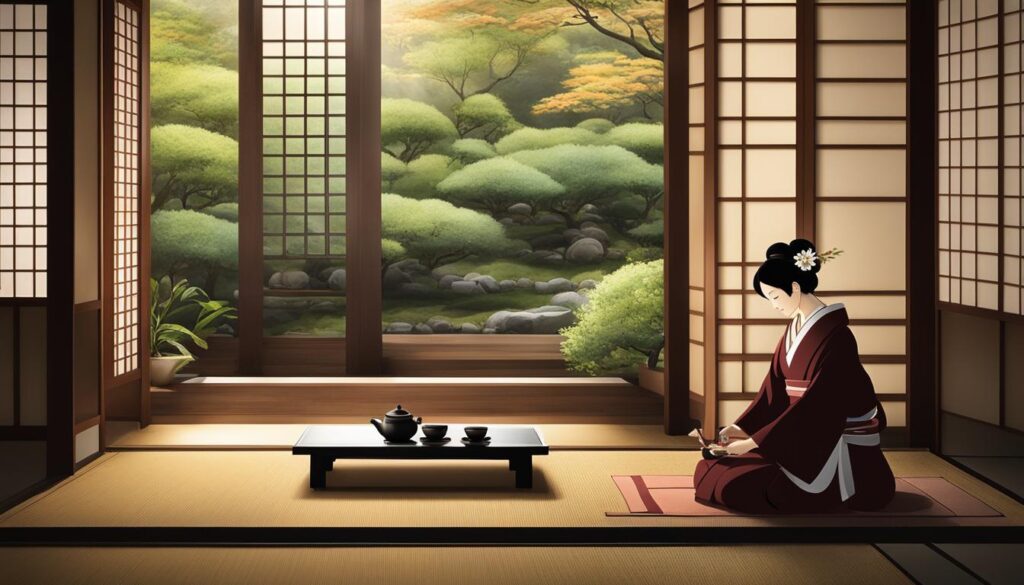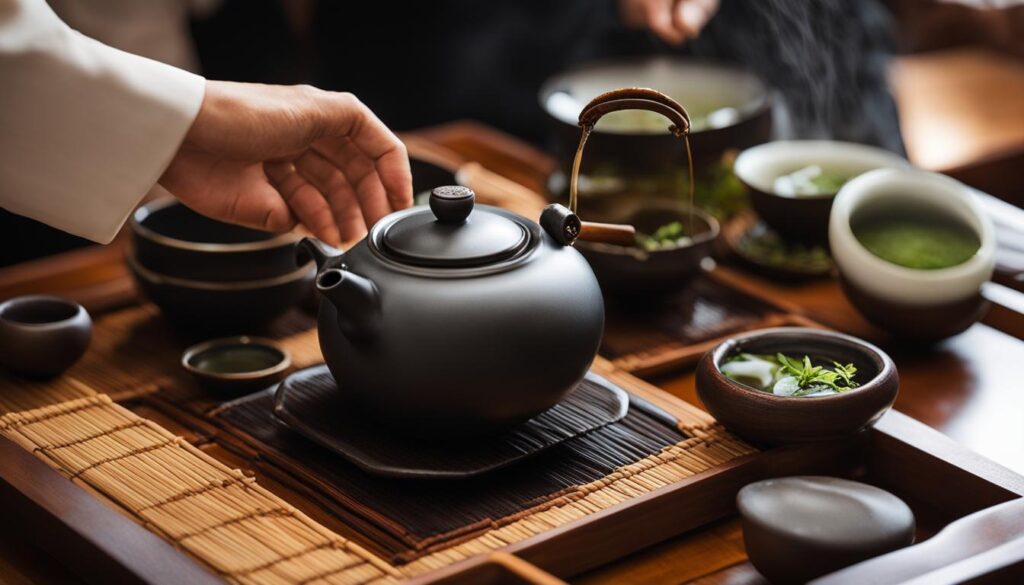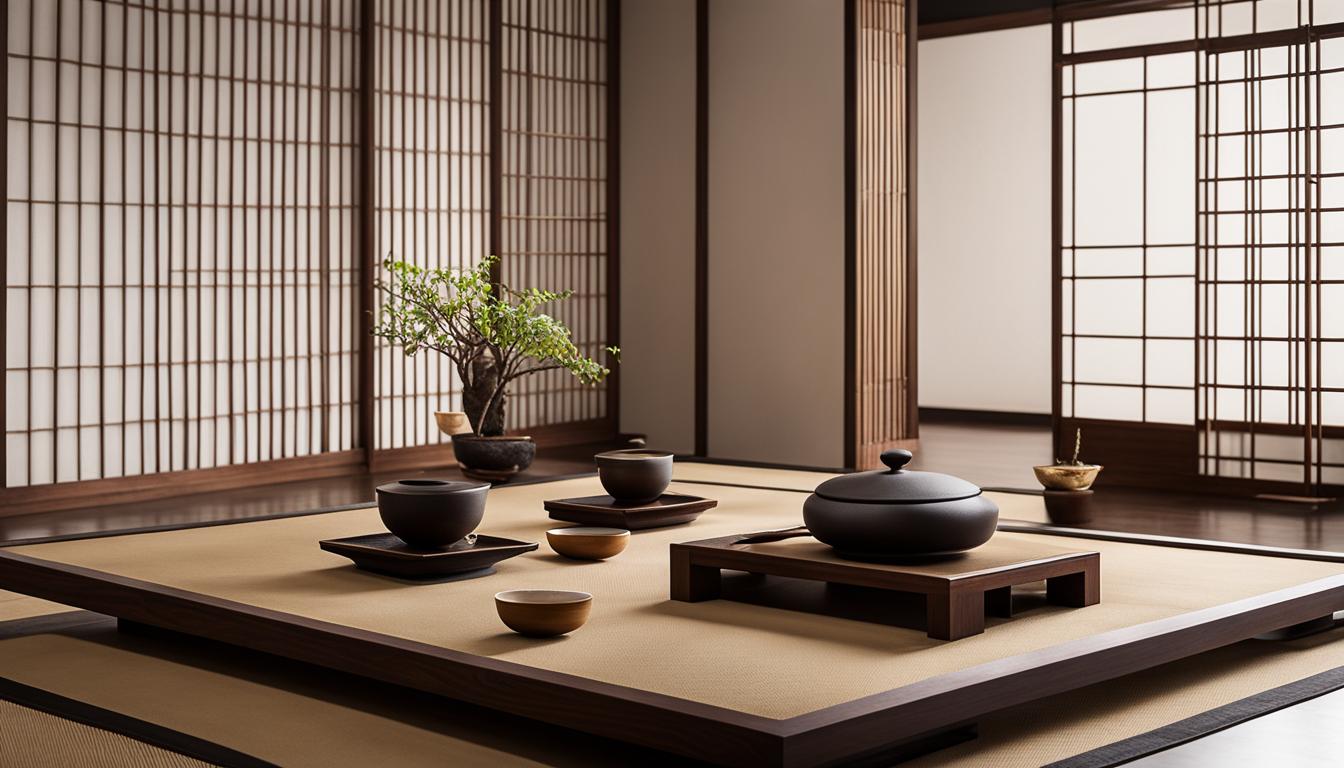Tea, a beverage loved and cherished around the world, holds a special place in the cultures of Japan and China. It’s not just a simple drink; it’s an art form, a spiritual practice, and a symbol of cultural heritage. In this article, we will delve into the rich cultural significance of tea ceremonies in both Japan and China, exploring their historical origins and the roles they play in these nations’ cultural traditions.
Key Takeaways:
- Tea ceremonies in Japan and China are deeply rooted in cultural and historical importance.
- Tea ceremonies are seen as a way to display hospitality, respect, and honor guests.
- Tea ceremonies hold spiritual importance, believing to purify the mind and body.
- Asia is home to various types of tea, each with its own unique cultural significance.
- The preparation of tea in tea ceremonies involves intricate and precise methods.
The History of Tea in Asia
Tea has a rich and fascinating history in Asia, spanning thousands of years. Its origins can be traced back to China in the 3rd century BCE, where it was initially used for its medicinal properties. Over time, tea became a popular beverage and its cultivation and preparation evolved into an art form. In the 9th century CE, tea was introduced to Japan, particularly among the samurai class, and tea ceremonies began to emerge as a cultural practice.
The influence of tea on Asian culture cannot be overstated. Tea ceremonies have played a significant role in preserving traditions and cultural practices. They are a way to honor guests, show respect, and display hospitality. Tea ceremonies are often held during important events and celebrations, symbolizing cultural values and rituals. These ceremonies also hold spiritual importance in many Asian countries, as tea is believed to purify the mind and body.
“Tea is not just a beverage; it is a cultural experience. It is a way for us to connect with our heritage and honor the traditions that have been passed down through generations.”
Tea ceremonies showcase the artistry and attention to detail inherent in Asian cultures. Each step of the tea preparation process is carefully executed, from the selection of tea leaves to the precise measurement of water temperature. The ceremonies highlight the importance of mindfulness and the appreciation of the present moment. Through the rituals and traditions of tea ceremonies, cultural identities are not only reinforced but celebrated, ensuring the preservation of Asian cultural heritage for future generations.
| Country | Type of Tea |
|---|---|
| China | Oolong tea |
| Japan | Green tea |
| India | Black tea |

The Art of Tea Preparation in Tea Ceremonies
The preparation of tea in tea ceremonies is a meticulous and deliberate process, adding to the cultural significance and artistry of the ceremonies. In Japan, green tea is typically prepared using the traditional method called “temae.” This method involves careful measurement and pouring of the tea into a bowl, showcasing the precision and attention to detail valued in Japanese culture. In China, oolong tea is prepared using the “gongfu” method, which utilizes special teapots and cups. These distinct methods of tea preparation contribute to the unique cultural experiences provided by tea ceremonies in different Asian countries.
The impact of tea on Asian culture cannot be understated. It has become a common cultural icon, representing hospitality, friendship, and spirituality. Tea ceremonies act as a reflection of traditional values and practices, serving as a reminder of the rich cultural heritage present in Japan, China, and other Asian countries. The preservation of tea ceremonies ensures that these cultural traditions continue to be celebrated and appreciated for years to come.
- Tea has a rich history in Asia, dating back thousands of years.
- Tea ceremonies showcase the artistry and attention to detail of Asian cultures.
- Tea plays a significant role in preserving cultural traditions and practices.
- The preparation of tea in tea ceremonies is a meticulous and deliberate process.
The Cultural Significance of Tea Ceremonies
The tea ceremony holds a prominent place in Japanese and Chinese cultures, serving as a cultural ritual that embodies centuries-old traditions and customs. These ceremonies have deep-rooted cultural significance and play a vital role in shaping the cultural identity of these countries.
In Japan, the tea ceremony, known as chanoyu, is considered an integral part of life and is associated with hospitality and respect. It is a way to honor special guests and to showcase the artistry and etiquette that are central to Japanese culture. Tea ceremonies in Japan are characterized by their harmony, simplicity, and attention to detail, creating a serene and contemplative atmosphere.
Similarly, in China, tea ceremonies, known as chado, hold significant cultural importance. Tea is served during important events such as weddings and funerals, symbolizing hospitality, respect, and cultural values. The Chinese tea ceremony focuses on the appreciation of tea and its flavors, as well as the harmony between nature and humans. It is a way to connect with one’s inner self and find balance.
Tea ceremonies have become renowned for their deep cultural significance in both Japan and China. They are not merely about consuming tea, but rather about appreciating the aesthetics, practicing mindfulness, and reinforcing cultural identities.
These tea ceremonies have transcended their cultural boundaries and gained recognition worldwide for their artistic value and spiritual significance. By partaking in a tea ceremony, one can experience the rich cultural heritage of Japan and China while simultaneously engaging in a meditative and introspective practice.
| Country | Tea Ceremony Name | Key Cultural Significance |
|---|---|---|
| Japan | Chanoyu (Japanese Tea Ceremony) | Hospitality, respect, artistry, simplicity |
| China | Chado (Chinese Tea Ceremony) | Hospitality, respect, appreciation of nature, harmony |
Overall, tea ceremonies are more than just a way to enjoy tea; they are a reflection of the cultural values, traditions, and identities of Japan and China. By participating in these ceremonies, individuals can gain a deeper understanding of these countries’ rich histories and immerse themselves in the beauty and tranquility of the tea culture.
The Art of Tea Preparation
The art of tea preparation is a fundamental aspect of tea ceremonies in both Japan and China. The preparation methods are steeped in tradition and play a crucial role in enhancing the cultural significance of these ceremonies.
In Japan, the tea is prepared using the traditional method called “temae.” This method involves precise measurements, specific utensils, and meticulous movements to create a harmonious and balanced cup of tea. Each step in the process is carefully performed, from measuring the tea leaves to whisking the tea into a frothy consistency.
Meanwhile, in China, the tea preparation method known as “gongfu” is practiced. This method emphasizes the precise control of temperature and the careful selection of tea leaves. The tea is brewed in small teapots and served in small cups, allowing for multiple infusions to fully appreciate the flavor and aroma of the tea.
The art of tea preparation in tea ceremonies adds an element of theater and craftsmanship, elevating the experience and capturing the essence of the cultural rituals. It is through these intricate techniques that the cultural significance of tea ceremonies is brought to life.
Types of Tea in Asian Culture
Asia is renowned for its rich and diverse tea culture, with each country having its own unique types of tea that hold significant cultural importance. Let’s take a closer look at three of the most prominent varieties of tea in Asian culture: Green tea in Japan, Oolong tea in China, and Black tea in India.
Green tea in Japan
In Japan, green tea, known as matcha, is the most commonly consumed and celebrated type of tea. It has a vibrant green color and a distinctively earthy flavor. Green tea is deeply ingrained in Japanese traditions and is an integral part of the famous Japanese tea ceremony, where it is prepared and served with meticulous attention to detail. The ceremony not only highlights the cultural significance of green tea but also showcases the precision and artistry involved in its preparation.
Oolong tea in China
China is known for its vast array of teas, but one of the most beloved is Oolong tea. Oolong tea falls between green and black tea in terms of oxidation, resulting in a unique flavor profile that is both floral and toasty. Oolong tea is often enjoyed during elaborate Chinese tea ceremonies, where it is brewed repeatedly in small clay teapots, emphasizing the ritualistic nature of tea preparation and consumption. Oolong tea is deeply intertwined with Chinese culture and is cherished for its calming and rejuvenating properties.
Black tea in India
In India, black tea reigns supreme. It is commonly known as chai and is a staple in the daily lives of millions of Indians. Black tea is typically brewed with a blend of aromatic spices such as cardamom, cinnamon, and ginger, creating a bold and flavorful beverage. In Indian culture, serving and sharing tea is a gesture of hospitality and warmth, and it plays an integral role in social gatherings and festive celebrations. The robust flavor and invigorating qualities of black tea make it a beloved part of Indian cuisine and culture.
| Tea Type | Country | Characteristics |
|---|---|---|
| Green Tea (Matcha) | Japan | Earthy flavor, vibrant green color, ceremonial importance |
| Oolong Tea | China | Floral and toasty flavor, meticulously brewed in clay teapots |
| Black Tea (Chai) | India | Robust flavor, blended with aromatic spices, symbol of hospitality |
The Art of Tea Preparation in Tea Ceremonies
Tea ceremonies in Japan and China involve intricate and traditional methods of tea preparation. These methods not only showcase the cultural heritage of each country but also add to the artistry and significance of the ceremonies. In Japan, the traditional method of preparing tea, known as “temae,” is followed with precision and attention to detail.
The tea host carefully measures and pours the tea into a bowl, creating a harmonious balance between the tea’s flavor and aroma. The process is a performance in itself, with every movement deliberate and intentional. Each step of the tea preparation has symbolic meaning, reflecting the underlying principles of harmony, respect, purity, and tranquility.
Tea ceremonies are not just about drinking tea but also about experiencing a moment of mindfulness and connection. The precise process of tea preparation fosters a sense of calm and awareness, allowing participants to appreciate the beauty of simplicity and the present moment.
In China, the tea preparation method known as “gongfu” is followed during tea ceremonies. This method employs special teapots and cups, along with precise brewing techniques. The tea leaves are steeped multiple times to extract their full flavor, resulting in a rich and aromatic brew.
The art of tea preparation in both Japan and China reflects the cultural values and traditions of each country. It is a way to honor and celebrate the tea itself, as well as the connection between the tea drinker and the natural world. Through the meticulous process of tea preparation, participants can immerse themselves in the ritualistic and meditative qualities of the tea ceremony.
| Japan | China | |
|---|---|---|
| Method | Temae | Gongfu |
| Utensils | Special tea bowls, bamboo whisk, tea scoop | Teapots, tea cups, tea tray |
| Brewing | Gentle whisking of green tea powder | Multiple steepings of tea leaves |
| Philosophy | Harmony, respect, purity, tranquility | Attention to detail, appreciation of nature |

The Symbolic Nature of Tea Preparation
Tea preparation in both Japan and China goes beyond the simple act of making a beverage. It is a deeply symbolic process that reflects cultural values and spiritual beliefs. Each movement and gesture during tea preparation carries meaning and intention, creating a harmonious experience for both the tea host and the guests.
- Precision: The precise measurements and careful pouring of tea symbolize the importance of balance and harmony in life.
- Mindfulness: The slow and deliberate movements of the tea host encourage participants to be present in the moment and appreciate the beauty of simplicity.
- Connection: Tea preparation fosters a sense of connection between the tea drinker and the natural world. The ritualistic process serves as a reminder of our interconnectedness with nature.
In conclusion, the art of tea preparation in tea ceremonies is an integral part of the cultural traditions of Japan and China. It represents more than just a beverage, but a way of life, encompassing principles of harmony, respect, and mindfulness. By participating in tea ceremonies and experiencing the meticulous process of tea preparation, individuals can gain a deeper understanding and appreciation for the cultural significance and artistry of tea.
The Impact of Tea on Asian Culture
Tea has had a profound impact on Asian culture, transcending its role as a simple beverage and becoming a symbol of hospitality, friendship, and spirituality. It has woven itself into the fabric of society, playing a significant role in cultural events and everyday life. The tea ceremony, in particular, has become a common cultural icon, representing centuries-old traditions and customs in countries like Japan and China.
Throughout history, tea has been served during important events, signifying the values and traditions of Asian culture. Whether it’s the elegant tea ceremonies of Japan or the elaborate tea rituals in China, tea holds a special place in the hearts of the people. It acts as a bridge, bringing individuals together and fostering a sense of community and connection.
Tea is more than just a beverage; it is a cultural experience that celebrates the art of preparation, the act of sharing, and the mindful appreciation of the present moment.
As a cultural icon, tea has made its way into popular culture, appearing in literature, art, music, and film. It has become a symbol of Asian identity, representing the rich history and heritage of the continent. From the delicate cherry blossom tea sets of Japan to the intricate teapots of China, tea has become synonymous with elegance, grace, and tradition.
The Role of Tea in Asian Culture:
- Symbol of hospitality and friendship
- Expression of cultural values and traditions
- Connection to spirituality and mindfulness
- Representation of Asian identity in popular culture
| Country | Type of Tea | Cultural Significance |
|---|---|---|
| Japan | Green tea (Matcha) | Focus on simplicity, harmony, and mindfulness |
| China | Oolong tea | Emphasis on tradition, ritual, and respect |
| India | Chai (Black tea) | Connection to hospitality and social bonding |
| South Korea | Jeoncha (Green tea) | Symbolizes peace, tranquility, and meditation |
In conclusion, the impact of tea on Asian culture cannot be overstated. It has become a common cultural icon that represents the values, traditions, and identities of countries like Japan, China, India, and South Korea. The tea ceremony, in particular, showcases the artistry and mindfulness associated with tea preparation, further emphasizing its cultural significance. Whether it’s sipping matcha in a traditional tearoom or enjoying a cup of chai with friends, tea has become a cherished part of Asian culture, embodying the essence of hospitality, friendship, and spiritual connection.
Conclusion
Tea ceremonies hold immense cultural significance in Japan and China, acting as a reflection of traditional values and practices. These centuries-old traditions continue to play a vital role in cultural events, showcasing the richness of both countries’ heritage. As a cultural heritage, tea ceremonies serve as iconic symbols of Asian culture, preserving and celebrating the cultural identities of Japan and China.
Tea ceremonies have found their place in traditional culture, representing the artistry and rituals that have been passed down through generations. The meticulous preparation of tea using specific methods and utensils adds to the beauty and significance of these ceremonies. They have become an integral part of life in both countries, acting as a way to honor special guests and display hospitality.
With their deep-rooted cultural significance, tea ceremonies will continue to be cherished and admired for generations to come. As Asian cultures evolve, these timeless traditions will remain an important part of their cultural fabric, reminding us of the beauty and richness of traditional practices.
FAQ
What is the cultural significance of tea ceremonies in Japan and China?
Tea ceremonies hold significant cultural and historical importance in Japan and China. They are considered art forms and spiritual practices that showcase the cultural heritage of these countries. Tea ceremonies are used to show respect, honor guests, and preserve cultural traditions.
How long has tea been a part of Asian culture?
Tea has a long history in Asia, dating back thousands of years. It originated in China during the 3rd century BCE and was later introduced to Japan in the 9th century CE. Since then, tea has become an integral part of Asian culture and is enjoyed in various forms and ceremonies.
What types of tea are popular in Japan, China, and India?
Green tea is the most popular type of tea in Japan, especially during tea ceremonies. Oolong tea is favored in China, and black tea is popular in India, often served with milk and sugar.
How is tea prepared in tea ceremonies?
The preparation of tea in tea ceremonies varies depending on the country and the specific type of tea being used. In Japan, green tea is often prepared using the traditional method called “temae,” which involves careful measurement and pouring of the tea into a bowl. In China, oolong tea is prepared using the “gongfu” method, which utilizes special teapots and cups.
What is the cultural impact of tea in Asia?
Tea has had a profound impact on Asian culture, symbolizing hospitality, friendship, and spirituality. Tea ceremonies and the cultural practices surrounding tea have become integral parts of Asian societies, representing traditional values and practices.





